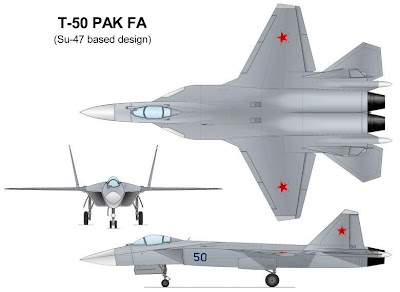
Lockheed has a leak.
Posted on 02/02/2010 9:03:50 PM PST by sukhoi-30mki
Sukhoi's Stealth Fighter May Be Quick Export to India
Posted by David A. Fulghum at 2/2/2010 9:12 AM CST
U.S. intelligence officials are closely monitoring the testing of Sukhoi’s T-50 stealth fighter prototype. It’s first flight from Komsomolsk has packed Russian blogs with pictures and videos taken from the base’s fence line and transcripts of in-flight conversations between Russian aircrews.
Funding aid for the program is expected to come from India, say U.S. officials. India's air force is becoming sophisticated and has adopted an operational flexibility and tactical innovation similar to U.S. Air Force and Navy fighter units.
The flights have answered some questions, but raised even more new ones.
“It is apparent that more concern has been paid to shaping, but there are still many surface intersections and flight test probes that will stress [increase the radar] signature,” says a senior Air Force officer involved in development of the F-117 and F-35. “In addition, we need to understand the internal mechanics of very large inlets to determine how and if engine blockage [of radar reflections] is achieved. In addition, those wing leading edge devices present challenges for [stealth] signature control.”
“Engines are going to be one of the long poles in the tent here,” says one of the U.S. analysts. “ It is unclear if in fact the aircraft is flying with the interim [117S] supercruise engine or just the AL-31FP’s like those in the Su-30MKI/MKA/MKM for the initial flights. The [refined supercruise] engine likely won’t be ready for several years to come, well beyond even IOC [initial operating capability].”
U.S. expectations are that the aircraft will undergo several more flight safety tests at Komsomolsk before testing shifts to Ramenskoye Flight test Center nearer Moscow to begin the test and development program. Estimates from U.S. officials are that the move will come in 6-8 weeks.
Senior Russian leadership have said that the first jet will be delivered to Lipetsk in 2013 where all new aircraft and upgrades to existing aircraft are thoroughly tested.
“Lipetsk will function as a sort of Nellis, sort of Edwards, sort of Eglin to wring out the jet, develop some basic combat employment doctrine and methodology, and write the flight manuals and weapons employment manuals,” the U.S. analyst says. “ Finally, they’ll train the initial IP [instructor pilot] cadre for the first line unit that will receive the jet -- probably 18-24 months after the first one arrives at Lipetsk. Whether they are able to meet the 2013 timeline is debatable, and depends on the success of the testing to come in the near term, the financial commitment the Russian government – and India’s government for that matter -- puts behind it, and, last but not least, whether there are any accidents."
For one perspective from India, see Bill Sweetman's post from Singapore yesterday, India Boost For T-50.

Lockheed has a leak.

India's a pretty big customer. If they're cheap enough, they'll be building these for quite a while.
$100 million each
Once read a white paper about how the enemy doesn’t need to match or even seriously challenge the f-22 to win. Just get something close enough (supercruise fighting etc.) and out build us and we would run out of planes. That was before we decided to stop making them.
” Just get something close enough (supercruise fighting etc.) and out build us and we would run out of planes. That was before we decided to stop making them.”
Yep. Obama sold America down the river.
(Yes, the river reference, with all its baggage, is intentional.)
It’s a nice looking bird.
That’s not the T-50 PAK FA. That is a MiG-based PAK FA offering that was rejected. Look at the close spaced engines and dual tailcones (very MiG-like) vs. the widely spaced engines and single larger tailcone (very Sukhoi-like.)

You are correct sir.
The most interesting aspect of the T-50 that flew (as seen in other images in this thread) is that the vertical stabilizers have no rudders. The vertical stabs are all-flying surfaces, just like the horizontal stabilizers on almost all modern high performance jets.
(In other words, there is no separate rudder on the vertical stab.)
From appearance, it looks like the whole ‘vertical’ stab can articulate. Seems like it is mounted on a powered pivot.
This isn't done on most aircraft. The F-35 even uses it's vertical stabs (minus the rudders) as fuel tanks.
See: http://www.defenseindustrydaily.com/images/AIR_F-35B_Cutaway_lg.jpg
It's a large image, so I didn't post it directly, out of respect to the bandwidth challenged.
Interesting.
Thanks for the picture.
Also, wouldn’t making the whole stab articulate, make it much weaker than a traditional stab?
No weaker than the all flyiny horizontal stabs are on just about every US fighter since the F-86 Sabre.
I also discovered that the F-35 wasn't unique in using the vertical stab as a fuel tank. The F/A-18E/F does it as well. I'm sure there are others, too, that I am not aware of.

Nice!
Thanks for the pictures and the details! I’ll look for more info on the measures taken to compensate for the reduced load-bearing area of the stabs on this aircraft.
Disclaimer: Opinions posted on Free Republic are those of the individual posters and do not necessarily represent the opinion of Free Republic or its management. All materials posted herein are protected by copyright law and the exemption for fair use of copyrighted works.